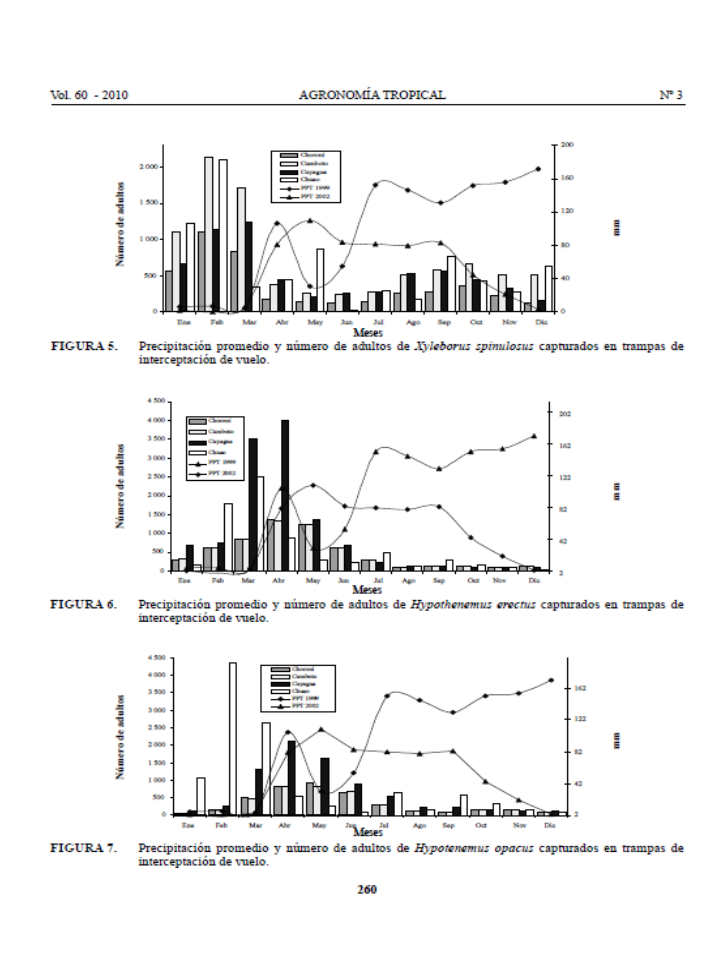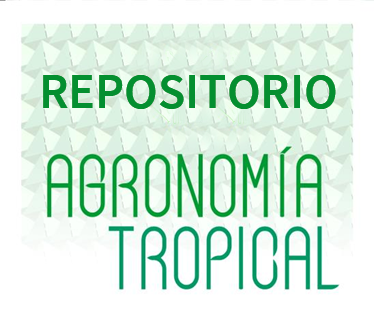Population fluctuation of Scolytidae (Insecta: Coleoptera) in cocoa of Aragua State, Venezuela
Abstract
The order Coleoptera includes species of the family Scolytidae as pests of forests in several regions of the world. The importance and density of this group are increasing in Venezuela mainly with species of ambrosia beetles, which feed on symbiotic fungi introduced and cultivated in their galleries. The objective of this research was to evaluate the occurrence and density of Scolytidae species damaging plants of cocoa in Cuyagua, Cumboto, Choroni and Chuao, State of Aragua, Venezuela. Ethanolic traps were used to study population fluctuation of Scolytidae species in plantations of cocoa. The Scolytidae species collected and identified of the tribe Xyleborini were Xyleborus ferrugineus Fabricius, X. affinis Eichhoff, X. spinulosus Blandford, X. vespatorius Schedl, X. volvulus (F.), Xylosandrus morigerus (Blandford), X. retusus (Eich.), Premnobius cavipennis Eichhoff, Sampsonius dampfi Schdl, Dryocoetoides nitidus Schedl y Xyleborinus sp., and of the tribe Cryphalini were Hypothenemus opacus (Eichhoff), H. erectus LeConte, H. sp. y Cryptocarenus sp. Likewise species that emerged from infected plants were collected X. ferrugineus (F), X. morigerus (Blanford), X. affinis, X. spinulosus Blandford, H. opacus (Eichhoff) and H. erectus LeConte. The last four species presented larger populations during periods of low rainfall while the first two presented other patterns. Population fluctuation was obtained for the six species that can be used in a program of Integrated Pest Management (IPM) in cocoa planting in Aragua State.
Downloads
References
• Chávez, I. P. 2009. Dinámica poblacional de larvas de Uresiphita reversalis (Guenée) en poblaciones naturales de Calia secundiflora (Ortega) Yakovlev. Tesis. Universidad Autónoma Chipango. México. 92 p.
• Goitía, W. y C. J. Rosales. 2001. Relación entre la incidencia de escolítidos y la necrosis del cacao en Aragua, Venezuela. Manejo Integrado de Plagas. CATIE, Costa Rica. 62:65-71.
• Guilford, J. P. y B. Fruchter. 1984. Métodos y problemas especiales de correlación. In: Estadística aplicada a la sicología y la educación. Editorial MacGraw-Hill. 265-333 pp.
• Ikeda, T., N. Enda, A. Yamane, K. Oda and T. Toyoda. 1980. Attractans for the Japanese pine sawyer, Monochamus alternatus Hope (Coleoptera: Cerambycidae). Appl. Entomol. Zool. 15:358-361.
• Iturre, M. y E. Darchuck. 1996. Registro de escolítidos relacionados al género Eucalyptus en Santiago del Estero. Rev. Quebracho. 4:11-16.
• Ministerio de Medio Ambiente y Recursos Naturales (MARN). 2000. Primer informe de Venezuela sobre diversidad biológica. Caracas-Venezuela. Oficina nacional de diversidad biológica. 227 p.
• Morales, N., J. Zanuncio, D. Pratissoli y A. Fabres. 2000. Fluctuación poblacional de Scolytidae (Coleoptera) en zonas reforestadas con Eucalyptus grandis (Myrtaceae) en Minas Gerais, Brasil. Rev. Biol. Trop.48(1):513-515.
• Noriega, J., J. Botero, M. Viola y G. Fagua. 2007. Dinámica estacional de la estructura trófica de un ensamblaje de Coleóptera en la Amazonía Colombiana. Rev. Colomb. Entomol. 33(2):157-164.
• Rondón, A. y Y. Guevara. 1984. Algunos aspectos relacionados con la muerte regresiva del aguacate (Persea americana Mill). Agronomía Trop. 34(1-3):119-129.
• Ulrich, G., N. Gerardo, A. Duur, D. Six and T. Shultz. 2005. The evolution of agriculture in insects. Annu. Rev. Ecol. Evol. Syst. 36:563-595.
• Vale, César. 1987. Bioecología y comportamiento de algunos Scolytidae (Coleoptera) en cacaotero (T. cacao) en Ocumare de La Costa. Tesis de Maestría. Maracay, estado Aragua, Ven. Universidad Central de Venezuela. 77 p.





